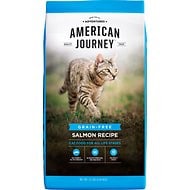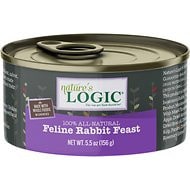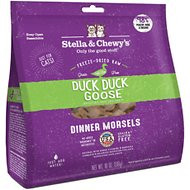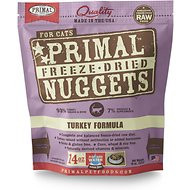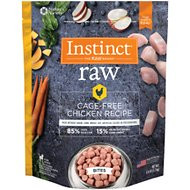Contents
- What Is The Best Hypoallergenic Cat Food?
- What is Hypoallergenic Cat Food?
- What Are the Benefits of Hypoallergenic Cat Food?
- Are There Any Special Considerations?
- What Should You Look for in a Good Cat Food?
- How Do We Make Cat Food Recommendations?
- The 10 Best Hypoallergenic Cat Foods
- Smalls Fresh Food Delivery
- Taste of the Wild Canyon River Grain-Free Dry Cat Food
- American Journey Salmon Recipe Grain-Free Dry Food
- Nulo Freestyle Minced Beef & Mackerel in Gravy Canned Food
- Now Fresh Grain-Free Senior Weight Management Cat Food
- FirstMate Turkey Formula Limited Ingredient Grain-Free Canned Food
- 4 More Top-Rated Hypoallergenic Cat Foods
- Frequently Asked Questions
When you hear the word hypoallergenic in the context of pets, you probably think about dog breeds that are less likely to trigger human allergies. Poodles, Yorkshire terriers, and Bichon Frise are often referred to using the label. The truth is, however, that it’s dander not hair that typically causes the issue and all dogs produce dander to some degree.
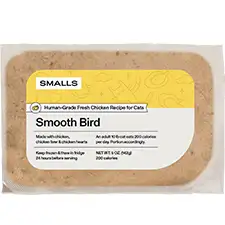
Smalls Human-Grade Ground Bird Fresh Cat Food
- Natural sources of taurine
- High in protein
Not only are there misconceptions about hypoallergenic breeds, but there’s misinformation out there about hypoallergenic pet food as well. There’s no such thing as a hypoallergenic cat food in the sense that different cats have different allergies – something that is considered hypoallergenic for one cat might not be for another cat.
In this article, we’ll talk about hypoallergenic cat food including what it is, its benefits, and special considerations to make before choosing this type of diet. You’ll also learn what you need to look for in a good cat food and see our top picks for the best hypoallergenic cat food.
What Is The Best Hypoallergenic Cat Food?
- Smalls Fresh Food Delivery
- Taste of the Wild Canyon River Grain-Free
- American Journey Salmon Recipe Grain-Free
- Nulo Freestyle Minced Beef & Mackerel
- Now Fresh Grain-Free Senior
- FirstMate Turkey Formula Limited Ingredient
- Nature’s Logic Feline Rabbit Feast Grain-Free
- Stella & Chewy’s Duck Duck Goose Dinner Morsels
- Primal Turkey Formula Nuggets Grain-Free
- Instinct by Nature’s Variety Frozen Raw Bites
What is Hypoallergenic Cat Food?
Cats are an entirely different species than humans, but there are some surprising similarities. For instance, cats can develop allergies in many of the same ways humans can. Not only can they be allergic to food ingredients, but they can also develop allergies to things in their environment such as pollen, mold, and dust – these are also known as inhalant allergies.
If your cat suffers from allergies, you may be considering hypoallergenic cat food. But what does that term actually mean?
In the strictest sense of the term, there is no such thing as hypoallergenic cat food. So what food is good for cats with allergies? Again, the answer isn’t always simple. It all depends what your cat is allergic to – the best cat food for cats with allergies is simply one that doesn’t contain the ingredients your cat is allergic to. That’s the true definition of hypoallergenic cat food.
Though there’s no single definition for hypoallergenic cat food, there are certain ingredients you should pay particular attention to. The most common cat food allergies are common proteins like beef, chicken, fish, and dairy products.
Though cats may not always be allergic to them, certain ingredients like fillers, by-products, and artificial additives can trigger a negative reaction as well.
What Are the Benefits of Hypoallergenic Cat Food?
Researchers aren’t quite sure exactly why pet food allergies occur, though many agree that it has something to do with an underlying health problem or imbalance in the body. The allergic reaction itself doesn’t develop due to exposure to the allergen, but because the cat has become susceptible to it in some way. A compromised immune system (potentially caused by a poor-quality diet) can put an unnecessary burden on the body, making your cat more prone to allergies.
The benefits of hypoallergenic cat food are related to their ability to resolve cat food allergy symptoms. Here are some of those benefits:
- Reduced itching and scratching
- Improved skin and coat condition
- Relief from chronic ear infections and yeast
- More regular digestion, less upset
- Reduce vomiting and diarrhea
- Improved energy and wellbeing
These benefits of hypoallergenic cat food are very general because every cat will respond to a change in diet differently. It matters less that the recipe is labeled “hypoallergenic” and more that it is a high-quality recipe made without the ingredients your cat is allergic to.
Are There Any Special Considerations?
Generally speaking, there are no drawbacks to hypoallergenic cat food as a whole. The main point of choosing a hypoallergenic recipe is to address cat food allergy symptoms and to resolve them. As long as the cat food you choose is free from the ingredients your cat is allergic to, it can be considered hypoallergenic and it should be a better option than what you’re currently feeding him.
One thing you need to consider, however, is that just because a cat food is hypoallergenic that doesn’t necessarily make it a high-quality cat food. You still need to do your homework.
Pet food manufacturers are businesses like any other. Their goal is to make as much money as possible which means manufacturing their products at the minimum cost while selling them for maximum profit. To do so, they often choose cheaper ingredients. When it comes to things like protein, chicken is an affordable option, but it isn’t necessarily better or worse than something like beef or turkey. It all depends on how the company plans to market the product.
When shopping for cat food, you need to keep your cat’s nutritional requirements in mind first and foremost. After that, you can take a closer look at the product and compare it to the alternatives to make the best choice. Read on to find out what you should look for in a good cat food.
What Should You Look for in a Good Cat Food?
Avoiding a product that contains the ingredients your cat is allergic to is step number-1 in shopping for hypoallergenic cat food. Additionally, you need to evaluate the quality of the product to make sure it’s a good fit for your cat. Limited ingredient cat food is often a good choice because there are fewer ingredients for your cat to potentially react to, but not all cat foods made with a low number of main ingredients are marketed as “limited ingredient.” You’ll still have to check the label.
Here are some general things to look for in a good cat food:
- Real animal protein as the first ingredient. Protein is the most important nutrient in your cat’s diet and should be the first ingredient (ideally two of the top three in dry food). For cat food allergies, however, you need to be careful which protein you choose. You don’t necessarily need to go exotic (like kangaroo) but something your cat hasn’t had before (like turkey, rabbit, or duck) might be a safe choice.
- Blend of omega-3 and omega-6 fatty acids. Healthy fats are another essential part of your cat’s diet and should come from animal sources as well like chicken or beef fat. Most cats who are allergic to a certain protein can tolerate fat from the same animal, though you may choose to avoid all ingredients that come from that animal just to be safe.
- Natural sources for key nutrients. Nutritional balance is essential for good health and to help your cat rebuild his immune system. Natural sources for key nutrients like whole grains, vegetables, and fruits are a better source then synthetic supplements.
- Limited content of digestible carbohydrates. Digestible carbohydrates like whole grains and low-starch veggies can provide key nutrients as well as dietary fiber, but make sure the content is limited. The focus of your cat’s diet should be the protein.
- Balanced according to AAFCO standards. AAFCO exists to regulate pet foods and they have created profiles to establish the minimum requirements for key nutrients in cats. Make sure any cat food you purchase carries an AAFCO statement of nutritional adequacy.
Now that you know what to look for in a high-quality cat food recipe, you’re ready to start shopping on your own! Before you do, however, we want to tell you how we make our cat food recommendations so you know whether you can trust the picks we’ve reviewed in depth below.
How Do We Make Cat Food Recommendations?
Your cat deserves the best and that’s exactly what we want for him too! We would never recommend a product we wouldn’t be perfectly happy to feed out own cats. That being said, we recognize that all cats have different dietary preferences, and some have unique nutritional requirements. Your veterinarian is the best person to talk to about specific cat food allergies, but we’re happy to give you some general advice when shopping for hypoallergenic cat food.
Before a cat food can receive our recommendation, we need to make sure it meets the basic nutritional requirements for cats. Cats are obligate carnivores, so they have a biological need for meat in their diets. Real animal proteins like meat and poultry are best, though some cats with food allergies do well on fish-based diets. Animal fats are also important, but carbohydrate content should be limited. Of course, we also want to make sure the cat food is complete and balanced in terms of nutrient content.
Here are some general requirements for a cat food recipe to receive our stamp of approval:
- A source of high-quality animal protein as the first ingredient
- At least 30% crude protein for kittens and at least 26% for adults
- A minimum of 9% crude fat for kittens and adults
- A balance of omega-3 and omega-6 fatty acids, primarily from animal sources
- A rich blend of nutrients from natural sources and supplements, as needed
- Limited carbohydrate content from digestible sources (like whole grains and veggies)
- No low-quality fillers, by-products, or artificial additives (preservatives, dyes, or flavors)
The 10 Best Hypoallergenic Cat Foods
Cat food allergies are more than just a mild inconvenience. They may start with something insignificant like a little itching or maybe an ear infection. Without treatment, however, it could lead to recurrent skin problems, digestive upset, and even issues with the cat’s immune system. It’s within your cat’s best interest to switch to a hypoallergenic cat food, whatever form it may take. Here are our top picks:
| Our 2024 Picks: Best Hypoallergenic Cat Food | |||
Small Ground Bird Human-Grade Fresh Cat Food
|
CHECK PRICE | ||
Taste of the Wild Canyon River Grain-Free
|
CHECK PRICE | ||
American Journey Salmon Recipe Grain-Free
|
CHECK PRICE | ||
Nulo Freestyle Minced Beef & Mackerel
|
CHECK PRICE | ||
Now Fresh Grain-Free Senior
|
CHECK PRICE | ||
FirstMate Turkey Formula
|
CHECK PRICE | ||
Nature’s Logic Feline Rabbit Feast
|
CHECK PRICE | ||
Stella & Chewy’s Duck Duck Goose
|
CHECK PRICE | ||
Primal Turkey Formula Nuggets
|
CHECK PRICE | ||
Instinct by Nature’s Variety
|
CHECK PRICE | ||
Smalls Fresh Food Delivery

Taste of the Wild Canyon River Grain-Free Dry Cat Food
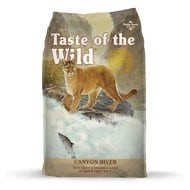
American Journey Salmon Recipe Grain-Free Dry Food
Most Affordable Hypoallergenic Cat Food: Finding a hypoallergenic cat food that’s affordable can be a challenge, but American Journey is an affordable brand overall. It all depends what your cat is allergic to, but this salmon recipe dry food could be good choice for cats with allergies to chicken, beef, lamb, or pork. Fresh salmon and salmon meal make up the top two ingredients, making this formula a rich source of both protein and omega-3 fatty acids. Canola oil provides omega-6s to balance out the omega-3s, supporting your cat’s healthy skin and coat as well as his immunity. This recipe also contains some fresh fruits and vegetables for natural nutrient sources with digestible grain-free carbohydrates as well.
Nulo Freestyle Minced Beef & Mackerel in Gravy Canned Food
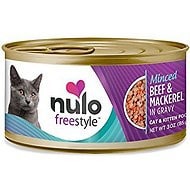
Now Fresh Grain-Free Senior Weight Management Cat Food
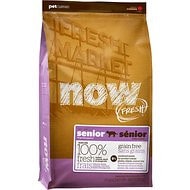
FirstMate Turkey Formula Limited Ingredient Grain-Free Canned Food
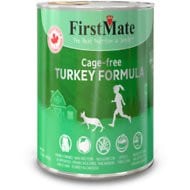
4 More Top-Rated Hypoallergenic Cat Foods
Nature’s Logic Feline Rabbit Feast Grain-Free Canned Cat Food
Made with an extremely limited list of ingredients, this Nature’s Logic Feline Rabbit Feast Grain-Free Canned Cat Food is a great choice for hypoallergenic cat food for many reasons. Not only does it contain a single source of novel animal protein, but it doesn’t contain added carbohydrates in any significant amount. Dried fruits and vegetables provide natural sources for key vitamins and minerals, but the estimated carbohydrate content is only about 3%. Rich in moisture and animal protein, this recipe is highly digestible and a rich source of nutrition for your cat.
Stella & Chewy’s Duck Duck Goose Dinner Morsels Freeze-Dried Raw Cat Food
If you’re looking to maximize your cat’s nutrition while minimizing the risk for allergies, this Stella & Chewy’s Duck Duck Goose Dinner Morsels could be a good choice. Freeze-dried cat food retains more of the original nutritional value than dry foods cooked at high temperatures, though you should rehydrate the food before feeding it to your cat. This recipe features duck and turkey as the main ingredients with goose for supplemental protein. It contains no added carbohydrates but does contain pumpkin seed to provide a balance of omega fatty acids for healthy skin and coat.
Primal Turkey Formula Nuggets Grain-Free Raw Freeze-Dried Cat Food
Another option in freeze-dried cat food is this Primal Turkey Formula Nuggets Grain-Free Raw Freeze-Dried Cat Food. It features turkey as the only source of high-quality animal protein, making it a good choice for cats with allergies to chicken, beef, fish, pork, or lamb. It contains no grains or high-starch carbohydrates, just fresh fruits and vegetables which offer natural sources for key nutrients. Overall, it is packed with protein and high-quality nutrition. Just be sure to rehydrate before feeding.
Instinct by Nature’s Variety Frozen Raw Bites Grain-Free Cage-Free Chicken Recipe
Raw cat food offers optimal nutrition because it hasn’t been cooked at high temperatures which can destroy the nutrients. This Instinct by Nature’s Variety Frozen Raw Bites Grain-Free Cage-Free Chicken Recipe is a good choice for cats with allergies because it contains a single source of protein, though it won’t work for chicken allergies. It contains a limited assortment of fresh fruits and vegetables to provide natural sources for key nutrients and doesn’t require a lot of added supplements. Overall, it’s a rich source of balanced nutrition for your cat and more closely approximates his natural biological diet than most commercial cat foods, especially dry food.
Frequently Asked Questions
- What is the most common food allergy in cats? The most common food allergies for cats are common proteins like beef, chicken, fish, and pork as well as dairy products. Most allergies are to proteins rather than fats or carbohydrates, though these things can sometimes trigger a negative reaction in cats who are sensitive to them.
- How can you tell if your cat is allergic to food? The only way you’re likely to suspect that your cat has food allergies is by noticing the symptoms. The most common cat food allergy symptoms are skin related instead of gastrointestinal which makes them different from humans. If your cat develops dry, itchy, and irritated skin along with recurrent ear or yeast infections, food allergies are a strong possibility. Talk to your veterinarian to rule out other possible underlying conditions and to ask about conducting a food trial to confirm the allergy.
- How do I know what my cat is allergic to? The only way to truly find out what your cat is allergic to is to conduct a food trial. You choose a diet made with out common allergens (especially the proteins included in your cat’s current diet and any he’s had before) and feed that only (no treats or snacks) for 8 to 12 weeks. Once signs of the allergy disappear, you can reintroduce common allergens in small amounts to see if your cat has a reaction. Whatever he reacts to is what he’s allergic to.
- What can you do for a cat with allergies? The only thing you can really do for a cat with allergies is change their diet to something that doesn’t contain the thing they’re allergic to. In addition to switching to hypoallergenic cat food, you may want to add skin- and coat-supporting supplements to help your cat heal from skin symptoms. Phytoplankton supplements are a great option because they are rich in omega-3s but aren’t prone to oxidation as much as fish oils. Probiotics can also help restore your cat’s microbiome which supports his immune system.
- Is grain-free cat food the best option? Not necessarily. There’s a common misconception in the pet community that grain-free foods are better but there’s nothing inherently wrong with grains (whole grains, at least). You still need to limit their inclusion in your cat’s diet because he won’t be able to digest them as well as animal products, but unless your cat has a grain allergy there’s no reason to avoid them entirely.
The next time someone starts talking about hypoallergenic dog breeds, you’ll know better than to follow the hype. You’ll also know what it means when someone talks about hypoallergenic cat food. It doesn’t really matter what other cat owners say as much as what you choose for your cat, however, because your cat’s specific allergies will be the determining factor.
We can’t tell you exactly which cat food to choose because cats can be allergic to a variety of ingredients. If you know what your cat is allergic to, however, you can check the recommendations above to see if there’s a good fit. Just remember to double-check the ingredients for yourself to make sure there’s nothing that might trigger your cat’s allergies.



